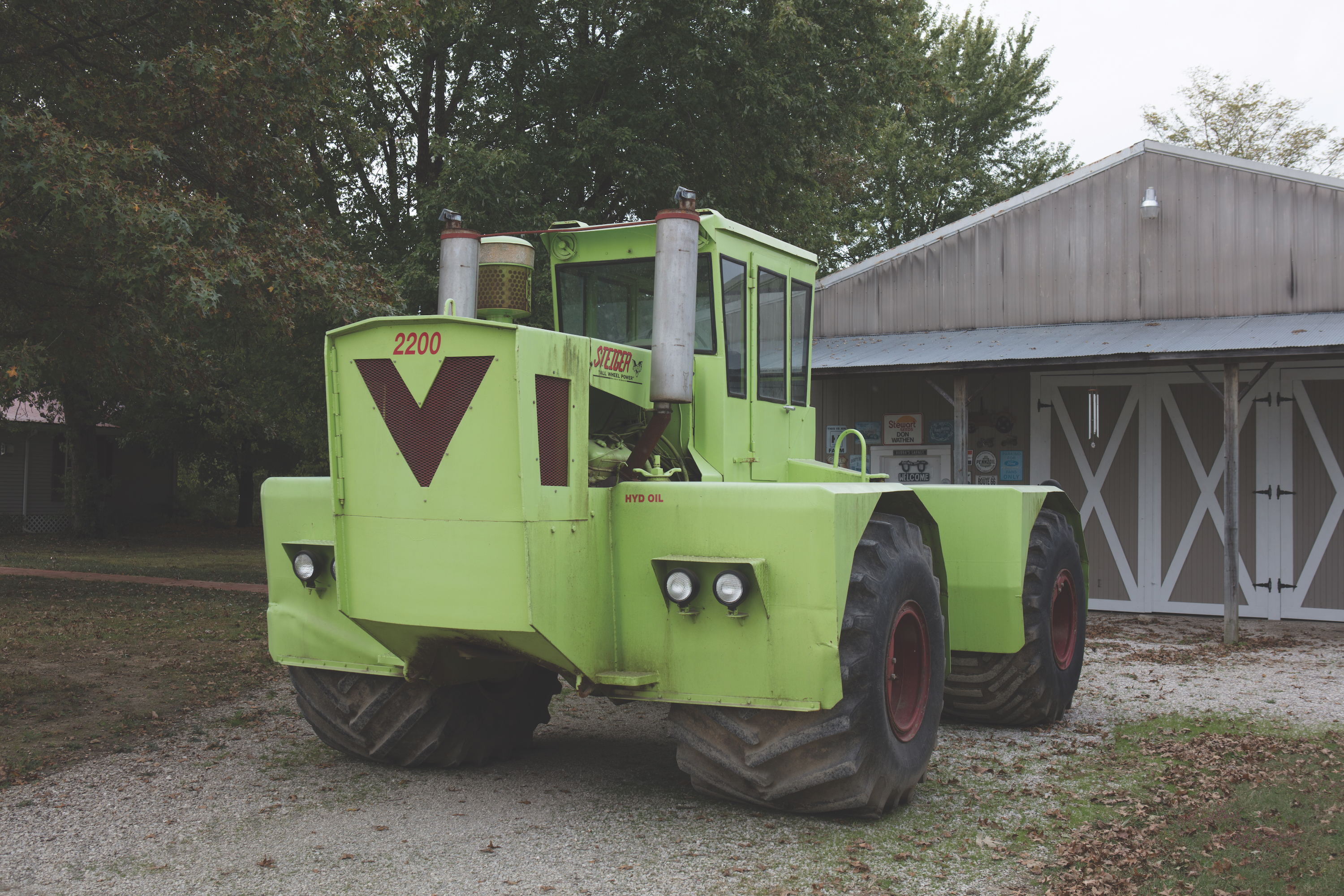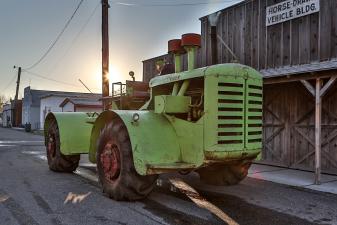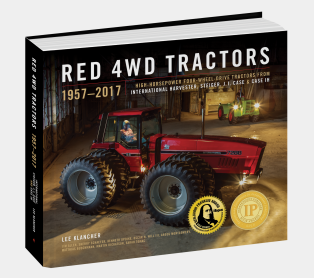Steiger's Most Important Sale of the Decade

The following is an excerpt from Red 4WD Tractors by Lee Klancher.
Perhaps the most important sale in Steiger's first decade occurred on April 22, 1968. Ken McIntyre purchased a Model 1700 with a cab with tinted glass and 23.1-inch-wide tires on a 26-inch rim for $20,307.48. That sale would change the course of the Steiger Tractor Company.
He drove the tractor home from the Steiger farm to the McIntyre farm near Prosper, North Dakota. Ken’s son, Murray, said the family had been farming for many years with a Caterpillar D-7 crawler. “The Caterpillar tractor had about 15,000 hours on it,” Murray McIntyre said. “It was pretty much wore out.”
Murray McIntyre took the new 1700 Steiger into the field to operate a 35-foot squadron hitch of cultivators formerly pulled by the Cat. The D-7 could average about 3 miles per hour. “The Steiger easily doubled the speed,” McIntyre said. “It just rolled across there doing more than twice as much work.” McIntyre was so impressed that he drove up to St. Hilaire to meet with Douglass Steiger. “I suppose I was just one of any number of people that showed up at the farm just asking darn fool questions,” McIntyre said. “He wouldn’t have known me from a Hogan’s goat, but he did give me the names of some individuals that they had sold tractors to in Manitoba and Saskatchewan and Montana and Minnesota.”

The logger models were introduced around 1966 and featured a blade and a cover over the operator. The 850 had a GM Diesel 3-53N rated for 90 horsepower, and the 1250 had a larger 4-53N GM Diesel rated for 130 horsepower. Both were advertised to have a pedal-operated reverser, which allowed you to change direction with your feet, as well as a two-speed winch. Steiger Family Collection
McIntyre had recently left DIMCO, a company based in Fargo that made the Big Dipper loader. Robert Kelly was the president at the time, and McIntyre showed him the Steiger brochure and indicated he was interested in getting involved with the company. Kelly suggested McIntyre dig into the issue, and McIntyre spent several months gathering information about the market demand for a large four-wheel-drive tractor. He reported back to Robert Kelly, who then contacted Douglass Steiger. The result was that 10 investors—Robert Kelly, Maurice and Douglass Steiger, Ken and Murray McIntyre, Robert Terry, Hugh Morris, Erling Falk, Carl Zick, and Robert C. Johnson—joined forces and formed Steiger Tractor Company, Incorporated, of Fargo, North Dakota, on January 22, 1969.
Kelly had previously worked for the Farm Hand company, and he brought in a number of salespeople from that organization. The new company was founded in Fargo and rented a building from Fargo Tank. That building was not the best facility—welder Darrell Lammers said the holes in the walls were so big rabbits ran in and out at will. The wind and snow did the same, and in February in Fargo, the snow and north winds blow sub-zero on a regular basis.
The building was rented from a recent Swedish immigrant, Ole Rommesmo, who had moved his company, Fargo Tank, into a new building. Vern Burns started working the tank building in 1969 and remembered the place well. “[Ole] was a very frugal,” Burns said. “He was not in any way, shape or form going to put his money back into that old building . . . it was in pretty sad shape.”

The Model 1700 was the smaller of the first two machines. More 2200s were produced than 1700s. This one is owned by Chris Wathens. Lee Klancher
He also said building tractors at that time was more like blacksmithing than welding, as the articulation joints, in particular, required tight tolerances and the equipment they had was not quite up to the task. The guys would lay a weld and then cut and grind and bend to get things to fit. Assembly was also complicated by the fact that the tractor moved around on carts, and one of the two cranes inside the building would occasionally block the other, slowing down work.
Production was slow, and sales were not much quicker in 1969. The incorporation of a new company did not instantly translate into success. According to early investor Murray McIntyre, Steiger sold 84 tractors and brought in $1.4 million in sales.
Back on the farm, Douglass and Maurice Steiger continued to build tractors to help out. Douglass believes he built about 20 tractors on the farm after the new company was incorporated in 1969. Douglass estimated he built a total 126 tractors on the farm, starting with Steiger #1 in 1958. Douglass was also still working to sell the tractors. Farmer Connie Danielson came to visit his farmyard and saw three or four Steiger tractors sitting on a circular patch of grass. “All ready for a photograph,” MaJeana Steiger Hallstrom wrote, “almost like a stage.”

The most popular of the barn-built Steigers was the 2200, which featured a fivespeed Spicer transmission with a two-speed dropbox (or power divider) designed by Douglass Steiger. While technically it had 10 forward speeds, the machine was advertised as a nine-speed transmission. Powered by a Detroit Diesel 6V71N engine rated for 238 horsepower, the big machine was one of the largest machines on the market in the 1960s. This example is owned by Chris Wathens. Lee Klancher
This farmer looked at the machines and turned to his son and said, “Son, next summer, you’re going to be driving one of those tractors. That’s the Cadillac of tractors.”
They didn’t hear from Danielson for a while, so Douglass called him. The farmer said he was going to buy a Versatile, because they cost less. Douglass called his salesperson from Fargo, and the two went to visit Danielson.
Douglass’s technique at the time was to lay out all the advantages of the Steiger in a notebook and compare it with the competition feature by feature. Danielson asked his wife to put on some coffee, and they all sat down at the table. Finally, the wife turned to Danielson and said, “Connie, why don’t you just buy the Steiger? You have not slept in ages; this had been bothering you so much.”
They wrote out the sale on the spot, and the next day Danielson drove out to the Steiger farm to see Douglass. “Thank you,” he said. “Last night was the first time I slept well in a month.”
PS: Interestingly, several other key moments in Steiger history took place in January. The announcement that Steiger would be building the 4366 four-wheel-drive for International Harvester came in January 1973. See this article, in January 1974, IH agreed to purchase a portion of Steiger and purchase contract-built machines for five years. This deal gave Steiger enough cash to build a new facility and grow.




